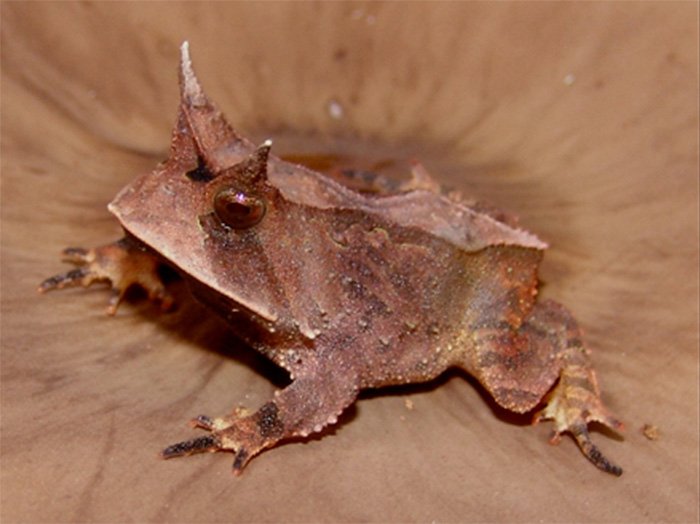Find the Frog
Alex Popovkin, Bahia, Brazil from Brazil, CC BY 2.0, via Wikimedia Commons
Odontophrynidae
by Inspector Barry Mins on October 25, 2022Hey kids, welcome back to our series on the mysteries of created kinds.
This week we move from birds to amphibians and from one side of the world to another. We head into the jungles of South America looking for some small frogs.

These frogs tend to live in leaf litter and small ponds on the forest floor.1 Some species prefer small streams.2 Most species are well camouflaged, but at least one species carries the gene for albinism.3 When disturbed, these frogs will flatten themselves against the ground and wait for the disturbance to go away.4
Males will call for females using what is known as an advertisement call. When they meet another frog, they will sometimes exchange an “encounter call.” These calls vary by species, with some emitting a single note5 while others emit a multi-note call.6 Females are bulkier but about the same length as males.7 Not much is known about the mating system of these species due to their rarity and sparse distribution.
Has anyone figured it out yet? This week’s kind is the Odontophrynidae—the smooth-horned frog kind. Stay tuned for next week when we head to sub-Saharan Africa, looking for another unresearched type of frog.
Clue
Your clue for the week is:
There are just over sixty species in this kind that live in a vast array of habitats.
Ask a Question
Have you ever had a question about created kinds but didn’t know who to ask? Have you ever wanted to learn more about your favorite kind? Well, now you can! You can ask me, Inspector Barry Mins, a question! Have your parents help you fill out this form, and you might get your question answered in my column! If you have any questions about created kinds, feel free to send them my way!
Footnotes
- C. V. de Mira-Mendes, D. S. Ruas, I. Castor, M. Solé, and J. E. Baumgarten, “Defensive behaviours in the Bahia forest frog Macrogenioglottus alipioi Carvalho, 1946 (Anura: Odontophrynidae), with a review of the stiff-legged posture,” Herpetology Notes 9 (2016): 91–94.
- A. Kwet and J. Faivovich, “Proceratophrys bigibbosa Species Group (Anura: Leptodactylidae), with Description of a New Species,” Copeia 1 (2001): 203–2015.
- E. A. Sanabria, L. B. Quiroga, and A. Laspiur, “First Record of Partial Albinism and Scoliosis in Odontophrynus occidentalis Tadpoles (Anura: Cycloramphidae),” Biological and Applied Sciences 53, no. 3 (2010).
- P. N. Costa, T. Silva-Soares, and L. B. Bernstein, “Defensive behavior of Proceratophrys boiei (Wied-Neuwied, 1824) (Amphibia, Anura, Cycloramphidae),” Herpetology Notes 2 (2009): 227–229.
- S. D. Rosset, D. P. Ferraro, L. Alcalde, N. G. Basso, “A revision of Odontophrynus barrioi (Anura: Neobatrachia): morphology, osteology, vocalizations, and geographic distribution,” South American Journal of Herpetology 2, no. 2 (2007): 97–106.
- L. B. Martins and A. A. Giaretta, “Morphological and acoustic characterization of Proceratophrys goyana (Lissamphibia: Anura: Odontophrynidae), with the description of a sympatric and related new species,” Zootaxa 3750, no. 4 (2013): 301–320.
- L. B. Quiroga, E. A. Sanabria, and F. Marangoni ,“Sexual size dimorphism and age in Odontophrynus c.f. barrioi (Anura: Odontophrynidae) from the Monte Desert, Argentina,” Journal of Herpetology 49, no. 2 (2015).
- © 2024 Answers in Genesis
- Privacy Policy
- Contact
- About



